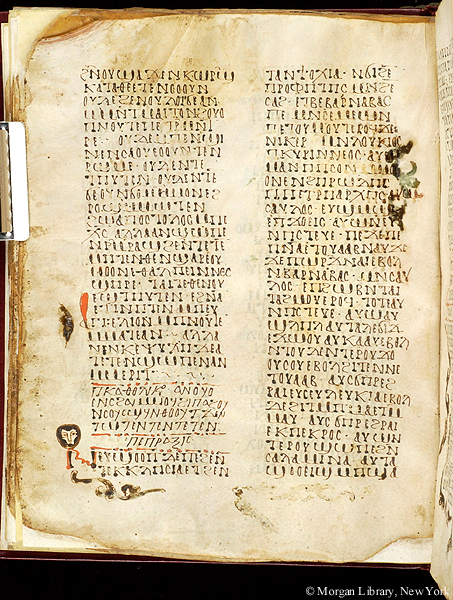
Manuscript Bible lectionary; written and illuminated in Egypt, ca. 822/23-913/14.
General title on fol. 1r: "With God. These are the lections which it is proper and suitable to read (arranged) according to feast and service for the entire year." Readings for the Mass, as follows: a) Pauline Epistle; b) Catholic Epistle; c) Acts; d) Psalm (with its number); e)gospel.
At the beginning of the textblock in the current binding is a textual fragment from the ancient binding pastedown inlaid in parchment: Pierpont Morgan Library MS M.573, f. i. This fragment is from a hagiographic narrative about a certain "blessed" John, who is said to be an archbishop, probably John Chrysostom archbishop of Constantinople, and also mentioning a certan Theognostus. It is written in 2 columns, with a written area of ca. 251 x 182 mm. Script: Upright. Division: Ekthesis and major or enlarged initial setting off paragraphs. Decoration: Paragraphus sign, major initial, extended letter. For full text, translation, and description, see Depuydt, no. 146.
Written area ca. 253 x 194 mm. Divisions: Single dot-and-dash divider. 1 column wide (mostly reddened), and enlarged, greatly enlarged, or major initial (mostly reddened) setting off major textual units (headed by date, name of feast day, and indication of lection); initial and paragraphus sign setting off paragraphs; some passages, especially quotations, marked by a small diple in margin of each line, as at fol. 74r. Exceeding letters of the last line of the chapter sometimes written in the margin (as at fol. 22v), or below (eg. fols. 19v, 32r) or above (eg. fols. 20v, 22r) end of the line..
Script: Upright. 10 lines = ca. 80 mm
Superlineation: Non-standard. Punctuation: Raised dot in conjunction with a space; spacefillers at the end of textual units. No tremas.
Collation: Quire ornaments; facing ornaments have different shapes. Monograms on A8, G8. No signatures, headlines or catchwords.
Scribe: Mōusēs.
Decoration: Headpiece on fol. 1r: tablet framing title, infilled with twisted rope interlace, 2 columns wide, followed by major initial and vine-scroll coronis. Marginal ornaments: head: 2 confronted doves separated by cross at fols. 12v, 16v (as quire ornament), 13r, 44v, 50r; square infilled interlace; fol. 64r, interlace cross; gutter on fol. 7r: human figure (probably Stephen, see text [Acts 1:59]); other, dove beside vine-scroll coronis accompanying initial (frequent); fol. 19r, bird (peacock?); human faces of saints at fols. 5r (with nimbus), 8r, 29r (with long hair or cape), 34r, 35r (twice), 36v, 39v, 42v (surmounted by cross), 47r (embedded in foliage ornament), 48r (with head-gear), 75r; fols. 27r (thrice), 29r, 33r, quadruped. Page numbers with horizontal rule sometimes reddened above and below, and sometimes decorated with 1 or 2 parentheses or other strokes. Colors: strong reddish orange, green (mostly faded or chemically altered).
